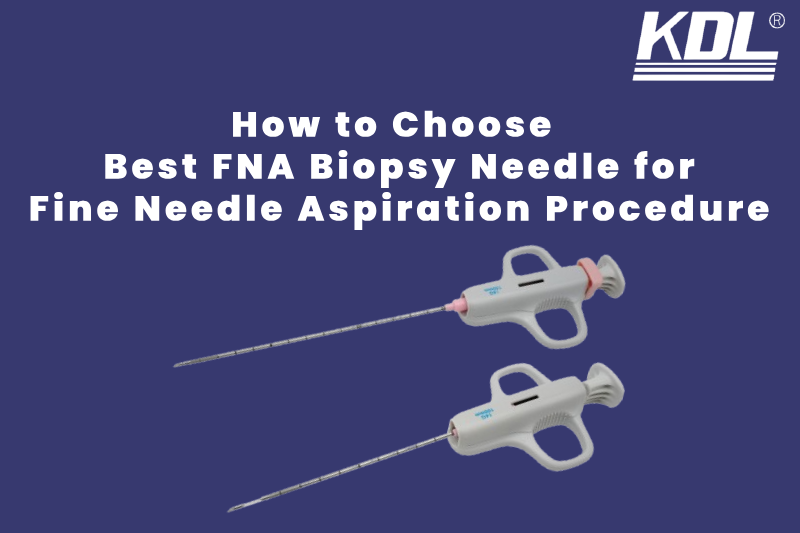
Fine Needle Aspiration (FNA) is an important tool in modern medicine, allowing doctors to collect cell samples from suspicious areas with minimal discomfort to the patient. Whether checking a thyroid lump, a breast mass, or a swollen lymph node, the accuracy of the results depends greatly on the FNA biopsy needle that used for the FNA procedure.
In this article, we’ll explore what makes an FNA needle effective, discuss the key features to consider, and look at how different needles are suited for various medical needs. By the end, you’ll have a better idea of which FNA biopsy needle is right for your practice.
What Is an FNA Biopsy Needle?
A Fine Needle Aspiration (FNA) biopsy needle is a specialized medical instrument that collects individual cells or fluid from a suspicious mass or organ. Unlike a core needle, which removes a tissue sample, the FNA needle aspirates only cellular material. A cytopathologist typically analyzes the sample under a microscope to identify malignancy, infection, inflammation, or benign pathology.
FNA needles find widespread use in specialties such as:
- Endocrinology (e.g., thyroid nodules)
- Oncology (e.g., lymph node evaluation)
- Radiology (image-guided biopsies)
- ENT and Head & Neck Surgery (e.g., salivary glands, neck masses)
FNA vs. Core Needle Biopsy: Why FNA Is Often Preferred
Fine Needle Aspiration has several clinical advantages over core biopsy techniques:
- Minimally invasive: Smaller needle means less tissue damage.
- Lower complication rates: Less bleeding, bruising, or infection.
- Faster recovery: Patients can return to normal activity almost immediately.
- Cost-effective: Uses fewer materials and can often be performed in an outpatient setting.
While core needle biopsy is better for evaluating tissue architecture, FNA is ideal for cytological diagnosis, especially in superficial or highly vascular structures.
What to Look for in the Best FNA Biopsy Needle
1. Needle Size
The size of the needle is one of the first things you’ll want to think about. Needles come in different sizes, and the size is measure by a gauge number. A higher gauge means a finer needle. For example, a 25-gauge needle is thinner than a 22-gauge needle.
- Thinner needles (like 25-27 gauge) are typically better for more delicate areas and cause less discomfort, but they may need several attempts to get a good sample.
- Thicker needles (like 21-22 gauge) are stronger and may be better for firmer tissues or when you need a larger sample.
2. Needle Length
Needle length is another key factor, especially if the tissue you need to sample is deep inside the body.
- Shorter needles (around 1-1.5 inches) are great for more superficial areas, like the skin or just under the surface.
- Longer needles (2–3 inches) are needed for deeper areas, like the lungs or deeper organs.
3. Sharpness and Tip Design
The tip of the needle should be sharp and easy to penetrate tissue. Many FNA needles have a beveled tip, which makes it easier to enter the tissue with minimal resistance. You’ll want a needle that slides in easily without causing unnecessary pain or injury to the surrounding area.
4. Coring Needles for Larger Samples
Some FNA needles are design to take a small piece or core of tissue. These are known as core needles, and they are ideal if the lesion is hard or deep, as they allow you to collect a larger sample. If you’re looking to get a better, more detailed sample, core needles might be the way to go.
5. Comfort and Ease of Use
The procedure should be as smooth and comfortable as possible for both the patient and the healthcare provider. Look for a needle with a good handle design—something easy to grip. A stable and easy-to-use needle ensures better precision when collecting the sample.
6. Safety Features
Needle safety is crucial. Some FNA needles have built-in safety features, such as automatic covers that protect the needle once the procedure is finish This reduces the risk of needle-stick injuries, which are a serious concern for both patients and healthcare providers.
7. Material and Coating
Most needles are made from high-quality stainless steel, which ensures durability. Some FNA needles also come with lubricated coatings that reduce friction, making the insertion smoother and reducing discomfort for the patient.
8. Single-Use vs. Reusable
FNA needles are usually single-use. This is because using a new, sterile needle every time reduces the risk of infection. Single-use fine biopsy needles come packaged in sterile wraps, so you can be sure that they are safe to use. Reusable needles, if available, must be thoroughly cleaned and sterilized between uses, which requires extra care.
9. Needle Compatibility
Make sure that the needle you choose is compatible with the equipment you’re using, whether it’s a syringe or an aspiration device. It’s also helpful to choose a needle that allows easy attachment and detachment during the procedure.
Where Are FNA Biopsy Needles Most Commonly Used?
FNA needles are incredibly versatile and used across many types of medical specialties. Here’s where they’re most helpful:
- Thyroid Nodules: One of the most common uses. A small lump in the neck can be safely tested with a 25G needle.
- Breast Lumps: FNA helps rule out or detect early signs of breast cancer without surgery.
- Lymph Nodes: Swollen nodes in the neck, armpit, or groin can be sampled to detect infections or cancer.
- Salivary Glands & Soft Tissues: Helpful for checking minor glands or cysts.
- Liver & Lung Lesions (under ultrasound guidance): We use specialized FNA needles here, often with imaging assistance.
Each location may require a different needle gauge or design, which is why variety and flexibility in your needle inventory are so important.
Sterilization and Safety Tips for Using FNA Biopsy Needles
To ensure patient safety and accurate results, it’s essential to follow proper handling practices:
- Use Single-Use, Sterile Needles: This is the gold standard to prevent infection and ensure sharpness.
- Check Expiration Dates: Even unused needles degrade over time.
- Dispose in Sharps Containers: Never reuse or recap used needles.
- Wear Gloves and Use a Clean Work Surface: Cross-contamination can ruin your sample and put the patient at risk.
Following these best practices helps keep your procedures safe, reliable, and professional.
Final Thoughts
Selecting the best FNA biopsy needle for fine needle aspiration procedures means considering more than just gauge size. From tip design and internal lumen to packaging and echogenic features, every element plays a role in delivering reliable samples and improving procedural success rates.
For clinicians, radiologists, and healthcare procurement teams alike, understanding these variables ensures better patient care, improved diagnostic accuracy, and enhanced workflow efficiency.
A high-quality FNA biopsy needle isn’t just a tool—it’s a critical part of the diagnostic process.
KDL: Trusted Manufacturer and Supplier of Precision FNA Biopsy Needle
KDL is a trusted manufacturer and global supplier of high-precision FNA (Fine Needle Aspiration) biopsy needles, designed for accurate, minimally invasive tissue sampling. We engineer our FNA biopsy needles for smooth insertion, optimal sample collection, and maximum patient comfort. Manufactured under strict quality standards, KDL’s needles support reliable diagnostic results across various clinical settings.
With a strong focus on innovation and safety, KDL provides healthcare professionals with dependable tools for cancer screening, thyroid evaluation, and more. Partner with KDL for premium biopsy solutions trusted by medical teams worldwide.
 +86-791-8686-1216
+86-791-8686-1216 

